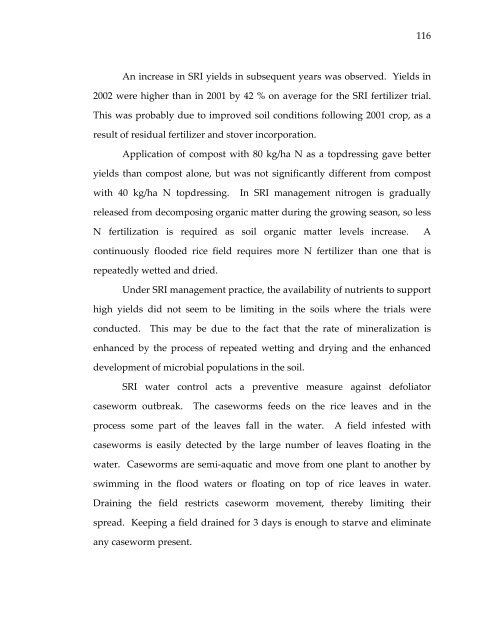Management of rice production systems to increase productivity
Management of rice production systems to increase productivity
Management of rice production systems to increase productivity
You also want an ePaper? Increase the reach of your titles
YUMPU automatically turns print PDFs into web optimized ePapers that Google loves.
116<br />
An <strong>increase</strong> in SRI yields in subsequent years was observed. Yields in<br />
2002 were higher than in 2001 by 42 % on average for the SRI fertilizer trial.<br />
This was probably due <strong>to</strong> improved soil conditions following 2001 crop, as a<br />
result <strong>of</strong> residual fertilizer and s<strong>to</strong>ver incorporation.<br />
Application <strong>of</strong> compost with 80 kg/ha N as a <strong>to</strong>pdressing gave better<br />
yields than compost alone, but was not significantly different from compost<br />
with 40 kg/ha N <strong>to</strong>pdressing. In SRI management nitrogen is gradually<br />
released from decomposing organic matter during the growing season, so less<br />
N fertilization is required as soil organic matter levels <strong>increase</strong>. A<br />
continuously flooded <strong>rice</strong> field requires more N fertilizer than one that is<br />
repeatedly wetted and dried.<br />
Under SRI management practice, the availability <strong>of</strong> nutrients <strong>to</strong> support<br />
high yields did not seem <strong>to</strong> be limiting in the soils where the trials were<br />
conducted. This may be due <strong>to</strong> the fact that the rate <strong>of</strong> mineralization is<br />
enhanced by the process <strong>of</strong> repeated wetting and drying and the enhanced<br />
development <strong>of</strong> microbial populations in the soil.<br />
SRI water control acts a preventive measure against defolia<strong>to</strong>r<br />
caseworm outbreak. The caseworms feeds on the <strong>rice</strong> leaves and in the<br />
process some part <strong>of</strong> the leaves fall in the water. A field infested with<br />
caseworms is easily detected by the large number <strong>of</strong> leaves floating in the<br />
water. Caseworms are semi‐aquatic and move from one plant <strong>to</strong> another by<br />
swimming in the flood waters or floating on <strong>to</strong>p <strong>of</strong> <strong>rice</strong> leaves in water.<br />
Draining the field restricts caseworm movement, thereby limiting their<br />
spread. Keeping a field drained for 3 days is enough <strong>to</strong> starve and eliminate<br />
any caseworm present.
















